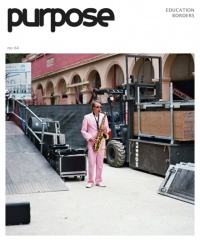
Analysis
Wandering journeyman, mobile creator

Artur Zaguła
For ages artists and their patrons were aware of the fact that the exchange of opinions and getting to know other point of view supports artistic educations and allows the creator to develop. But there also were some times and places where limitations in access to other cultures were great. We should mention for example the age of New Kingdom in ancient Egypt and the craftsmen settlement Deir el-Medina (ancient Set Maat) operating in the Valley of the Kings in Thebes. Occupied by builder and tomb decorators village was under thorough surveillance. Its dwellers, although endowed with many privileges, could not make any contacts with the outside world. It was favourable to creating an invariable standard - canon, which was obligatory for many centuries in the creations of Egyptian artists.
A slightly similar situation took place after Second World War, after dividing Europe with the "iron curtain". The Eastern Bloc very strongly limited the possibility of artistic exchange, not only in the geographic manner, but also ideological. Because of these reasons, Polish students could only go to countries that were on friendly terms with "people's democracy". In turn, the number of people leaving was limited by financial issues and the "political correctness" of those times - the only people who could leave were the members of Socialistic Polish Students' Union or Polish Students' Association (Socjalistyczny Związek Studentów Polskich, Zrzeszenie Studentów Polskich). Certain seclusion and ossification of artistic environments in these countries resulted from this.After 1989, thanks to joining European Union, there appeared some possibilities of foreign exchange, getting to know other cultures and artistic environments. Programmes such as Erasmus increase the mobility of Polish youth, their adaptation skills in various conditions, they also provide new experiences that can be used after returning to one's homeland. Nowadays we all know how important this is.
However, we should not think that this is a modern idea. Travel and visiting the workshops of other creators were the foundation of education long time ago. Let's go back in time and have a look at medieval craft guilds. The student started as an apprentice learning basic secrets of his profession. When he gained enough dexterity, after passing an exam, he became a journeyman. If he wanted to become a guild master, first he had to travel to various cities to gain experience in various workshops. Only after this mandatory journey, which sometimes included several European countries, he could create a masterpiece [the work which constituted the main test of his skills] and become a free guild master. Many journeymen could not afford to travel and they complained about this requirement, rebelling against it. Even several centuries later, Gustaw Mahler mentions the misery of a journeyman in his songs.
Later in history, visiting workshops of famous artists or studying on foreign university were practised by most of prominent creators. Even in the Baroque, people looked for solutions for institutional support of the most talented students. Louis XIV founded Prix de Rome for the most prominent students of Académie Royale de Peinture et de Sculpture in Paris. Since 1666, the winners could spend 3 to 5 years in Rome and live in Palazzo Mancini at French king's expense. Architects also received such possibilities in 1720.
Many king's courts sent their best artists abroad or often also hired foreign artists. Let's present some examples from Poland. An interesting case is the one of the court painter of Stefan Batory and Zygmunt III Waza, the portrait-painter Marcin Kober. He came from Wrocław and was a guild painter, and as every artist of this kind he underwent his 3-year-long journeyman travel, during which he stayed for example in Magdeburg. Then he stayed on Polish king's court, in Prague with Rudolph II and in Graz with Archduke Ferdinand. In turn, the court painter of Jan III Sobieski - Jerzy Eleuter Siemiginowski, was sent by the king to the Academy of Saint Luke in Rome, he also visited Paris and Vienna.
Both foreign creators (Marcello Bacciarelli, Canaletto) and Poles, who were the scholarship holders from his foundation studying abroad (Jakub Kubicki), stayed on Stanisław August Poniatowski's court. In 19th century, the majority of Polish artists participated either in regular foreign studies, or in studies journeys to Rome, Paris, Vienna, Munich and Petersburg. A big Polish artistic environment was established in Munich, and it was animated by Józef Brandt.
As it can be seen in these historical examples, in artistic education the most important things almost always and everywhere were: using various examples, travelling, getting inspired by environments different from the native ones. Let's leave then, gain experience, but then we should go back to our homeland to realise our projects there. Let's hope, that we will live to see the time in which a student coming from abroad will not be treated as a "dangerous rival" that should be ignored or destroyed, but that he/she will find a possibility to realise ideas born from experiences gained abroad.
Text: Artur Zaguła
Check the archive

no 64 April 2012
theme of the issue:
EDUCATION BORDERS
< spis treści
Article
From the Editors
Presentation
Young, talented
Analysis
Wandering journeyman, mobile creator - Artur Zaguła
Career in Culture
Go. Go fast. Go as soon as possible! - interviews with young artists Ola Niepsuj and Piotr Niepsuj - Agnieszka Furmańczyk
Cultural Industries
Skills issue - interview with Floris Solleveld, a documentalist from ELIA - European League of Institutes of the Arts - Agnieszka Furmańczyk





